In this multi-part series, we’re taking the guesswork out of watering the lawn. (For earlier segments, see Part 1 and Part 2.) In this post, we’ll continue looking at soil moisture sensors, discussing the importance of correct sensor placement.
Location, location, location…
A properly installed soil moisture sensor (SMS) effectively lets your sprinklers “decide” whether or not they need to run. As a result, these sensors can save water and some guesswork, since the sprinklers won’t run unless the ground needs the water. Simple, right?
Well, it turns out that choosing the correct location for the probe is important. (Like REALLY important.) There are several location factors to consider:
1) High & dry -or- shady & soggy?
Ideally, the SMS probe should be in an open, sunny area representative of the driest conditions in the lawn.
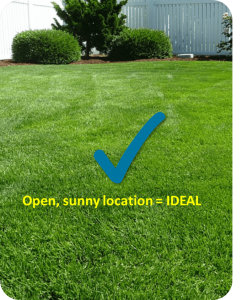
Otherwise, it might allow part of the lawn get brown & crispy while the sensor sits wet and happy in the shade. So for example, the SMS probe shouldn’t be:
- buried too deep,
- under a valve box cover,
- near a downspout,
- in a low drainage area (swale) between homes,
- below the roof’s drip-edge,
- under a shade tree (etc…)
In any of these locations, the soil would often be much wetter than the middle of the sun-drenched front yard. Result? The sensor would probably skip too many irrigation cycles, and the driest areas of the lawn might not get watered even though they’re getting brown and crunchy…
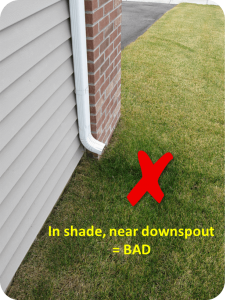
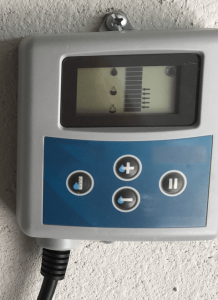
End result? A homeowner might try to over-compensate for a wet location by adjusting the watering threshold very, very wet – or – more often they’ll become frustrated and decide to bypass the sensor (and the water-savings) altogether...

2) Which zone?
Let’s say you have the following six-zone system.
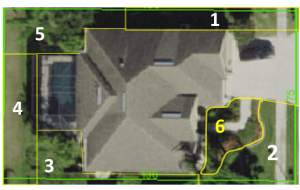
You’ve identified a nice sunny spot in Zone 2 as your ideal sensor location.
[IMPORTANT SIDE-NOTE: Sprinkler zones always run in consecutive numerical order, (i.e. Zone 1–> 2–> 3–> 4–> 5–> 6) I’ll explain why this is important in a minute…]
Let’s say that Zone 2 recently finished watering, and the SMS reading is now hits “saturated.”
Some models of SMS are designed to allow the entire watering cycle to finish running all of the remaining zones. However, other models will immediately turn off the sprinklers as soon as the sensor’s reading reaches the saturation-point. Neither style is necessarily better or worse – BUT it does make it REALLY IMPORTANT to know the specifics of your SMS equipment!
(Otherwise, some of your zones might NEVER receive water…)
The paradox of how to do it right:
Ok, so we know a couple of key things –
- You want the SMS probe to be in the driest turf location.
- Some SMS probes also need to be in the last zone to be watered.
In the scenario above, Zone 2 was chosen as an open, sunny turf location, but Zone 6 is currently the last zone to be watered. Because Zone 6 is a landscaped shrub bed with micro-irrigation, it’s definitely not representative of the driest turf areas. In other words, if we meet criterion #2, we fail on criterion #1, and vice versa.
Well, luckily there is a really simple solution…
SOLUTION:
(*Disclaimer: To avoid potential injury or damage of equipment, always disconnect power supply before working with wiring, or consult a licensed irrigation professional.)
Back at the sprinkler controller, each zone is wired into a numbered “slot.” You can actually reorder the sequence in which the zones are watered any way you choose, simply by swapping zone wires!* Voilà! The sensor can remain in the driest turf area, because that’s also now the last zone to be watered!
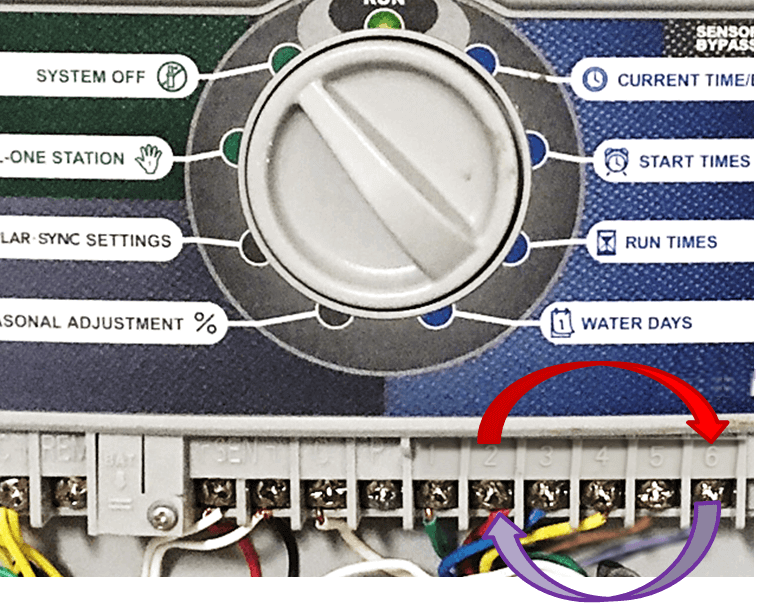

Final note:
This post got a bit long. One final note on the reason that an improper sensor location might be chosen. Many wired SMS probes** come with only a short length of wire attached. As a result, additional wire often needs to be added in order to achieve ideal placement in the middle of a sunny turf zone.‡ By trying to use only the short bit of wire provided, the sensors invariably were ending up near the valve box, along the side of the home, in the shade, below the roof drip-edge, in the drainage swale, next to the A/C condensate line…in other words, in all the wrong places!
Like the saying goes, “Location, location, location…”
**Note: Several models of wireless SMS also exist.
‡Important! Always use direct burial connectors for in-ground SMS wiring and follow manufacturer recommendations closely.
About UF/IFAS Extension:
UF/IFAS Extension serves as a source of non-biased, research-based information for the residents, businesses, and communities of Florida, providing educational materials and programs for adults and youth. We proudly “provide solutions for your life.”
UF/IFAS has local Extension offices throughout the state! Click to find your local office!
by Frank Galdo
 0
0
